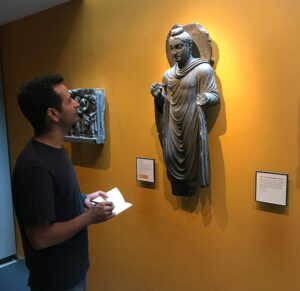30 Artists, 30 years – Peter Stewart
BF: As the Director of the Classical Art Research Centre at the University of Oxford, you have been the initiator of the project Gandhara Connections whose aim is ‘to stimulate and support the study of ancient Gandharan art and its links to the classical world of Greece and Rome, thousands of kilometres to the west.’ Started in 2016 and due to end next year, we have been proud to support this endeavour since its very beginning. Could you tell us a bit more about the project’s uniqueness and any new insights that your research has uncovered? What inspired you to involve also a contemporary artist, Ali Kazim, to be a part of it?

PS: Gandharan art is a deeply perplexing subject. It mainly concerns Buddhist sculpture made in the area around northern Pakistan in the first few centuries AD. When people started studying the remains of Gandhara in the middle of the nineteenth century they were astonished by the originality and complexity of the imagery, and Europeans especially were struck by how closely these Asian works of art seemed to echo Greek and Roman works made thousands of miles away. The fascination has continued and grown since then – Gandharan art is a hugely popular subject – but we still weren’t much closer to resolving some of the fundamental questions about it, including why the Gandharan artists wanted to appropriate aspects of the classical tradition.
When I started to think about how the Classical Art Research Centre could stimulate new work on this subject, I was surprised that there was no one obvious centre for information or study of Gandharan art. The people I regarded as leading experts were thinly spread across the world – In Pakistan and India, of course, but also Japan, South Korea, China, North America, across Europe… They were also in different academic disciplines and different sorts of institutions – and actually few of them would admit to being an expert!
So our Gandhara Connections project was not just about ancient art connections, but also connections between an international community today. Through our workshops and publications we’ve brought people together to share their ideas and knowledge, and I think we’ve made great strides in promoting cutting edge research on subjects like the dating of Gandhara and how it fits with the Roman world. But the project’s not only about research – it’s a much wider effort to share ideas and insights with all different kinds of audiences, including artists, students, collectors, and enthusiasts from all walks of life.
The idea of making the two thousand year leap to include the work of a contemporary artist in our programme came from several people, including the team at the Bagri Foundation. It was a way of looking at archaeology from a completely different angle. Ali Kazim is an acclaimed, Lahore-based artist who was interested in our project and has done stunning work on archaeological themes, so we were thrilled to be able to host him as artist in residence in summer 2019. He spent time looking at Gandharan art and other Asian artefacts in the Ashmolean Museum, and the new work that’s resulted will be exhibited there next year.
BF: Your research focuses on ancient sculpture, including Roman provincial art, Gandharan art, and the sculpture collection at Wilton House, for which you are completing the history and catalogue. Which are the specific streams of research to which you dedicate most of your attention these days?
PS: The strange thing is that I’ve increasingly found the different strands of research you’ve mentioned coming together. My latest book is a history and catalogue of an extraordinary eighteenth-century antiquities collection near Salisbury – it’s the culmination of twelve years’ work, examining the objects closely and piecing together their ‘biographies’. In the same way I’ve come to be interested in the history of Gandharan objects, particularly trying to reconstruct who collected them and where they came from. Meanwhile, the peculiar story of how Greek and Roman traditions came to be adapted by the Buddhists of Gandhara is closely tied up with understanding how the classical tradition spread through the provinces of the Roman Empire – so all these things relate to each other. I have started working on a book with the provisional title, Art of the Romans’ World – the apostrophe is important! I want to think about how works of art and art traditions moved around the ancient world, considering not just the Roman Empire itself, but also its links with Central and South Asia, as well as China and Africa.
BF: This year the much anticipated third workshop of the Gandhara Connections project, The Rediscovery and Reception of Gandharan Art, that was due to be held in March has been cancelled due to the global health crisis. What are your plans to disseminate your research and share knowledge and passion about Gandharan Art for the future? Has this new way of looking at live gatherings created new opportunities for international connections?
PS: In fact our 2020 workshop has been postponed rather than cancelled, and we are provisionally planning to hold it in March
One of the project’s live webcasts: Dr Abdul Samad, Director of Archaeology and Museums for Khyber Pakhtunkhwa Province (Photo: CARC)
2021 – but in completely virtual form! We’re sorry to lose some of the informal sharing that results from bringing different sorts of people together in Oxford, but strangely enough we are already very used to having a ‘virtual’ audience. CARC’s website is used by about 150,000 people every year – the audience for our online resources is truly global. So from the outset the Gandhara Connections project has been aimed at a web audience, with live webcasts and recordings of events, as well as our free online books and introductions to topics. At our workshops we always field comments and questions from people in China, India, the US – everywhere – who are watching the live webcast. What has changed for the better this year is that there’s been a massive development of the tools available for online conferencing. We’re still looking forward to the excitement and buzz of our events in the coming months!
The Bagri Foundation is pleased to announce the publication of “The Global Connections of Gandhāran Art.“ The newly released free-to-download publication, edited by Wannaporn Rienjang and Peter Stewart, presents the proceedings of the Third International Workshop of the Gandhāra Connections Project held on 18th-19th March 2019. More information can be found here.
Biography

Dr Peter Stewart is Director of the Classical Art Research Centre at Oxford University and Associate Professor of Classical Art and Archaeology. He was born in Belfast and educated at Cambridge University. He taught at Cambridge, Reading University and the Courtauld Institute of Art before moving to Oxford in 2011. His research focuses on Graeco-Roman sculpture and on relationships between different art traditions across the ancient world. He has particular interests in the cultures of China and South Asia (and is an OCI – an ‘Overseas Citizen of India’). Peter’s past publications have included Statues in Roman Society: Representation and Response (2003), The Social History of Roman Art (2008), and studies of the ancient Buddhist art of Gandhara. His latest book, out in September 2020, is A Catalogue of the Sculpture Collection at Wilton House.
Interviewed by Alessandra Cianetti, Project Manager – September 2020.


